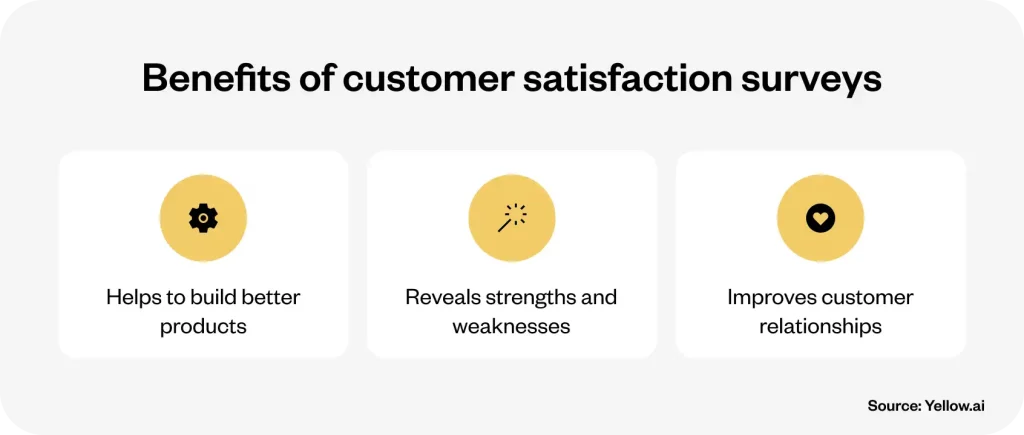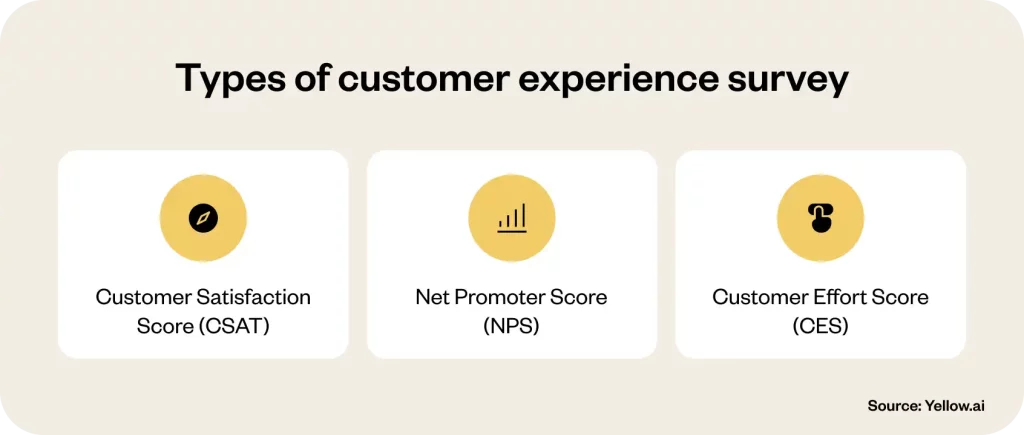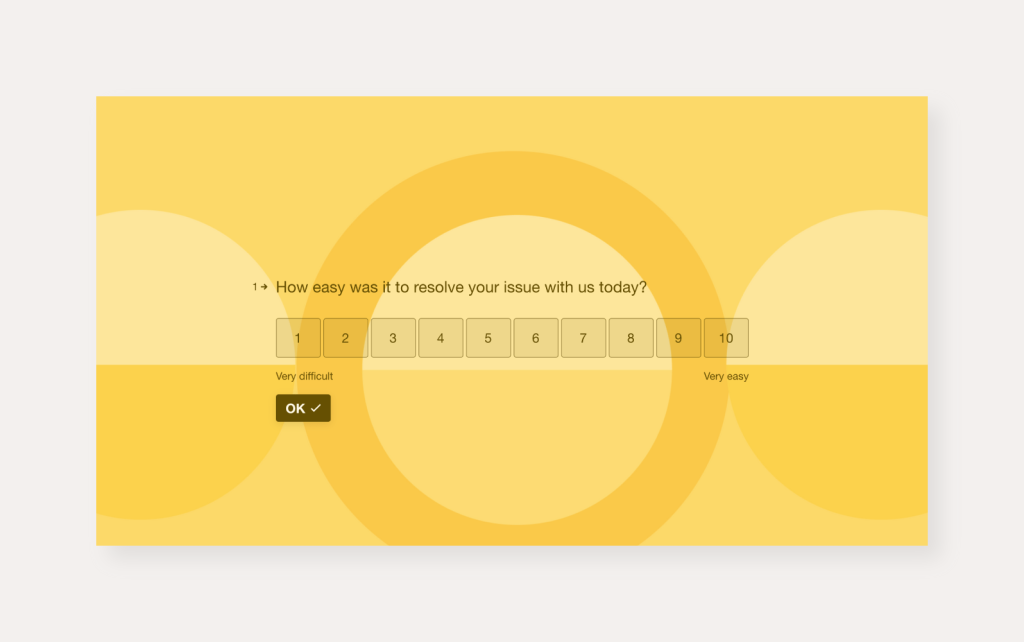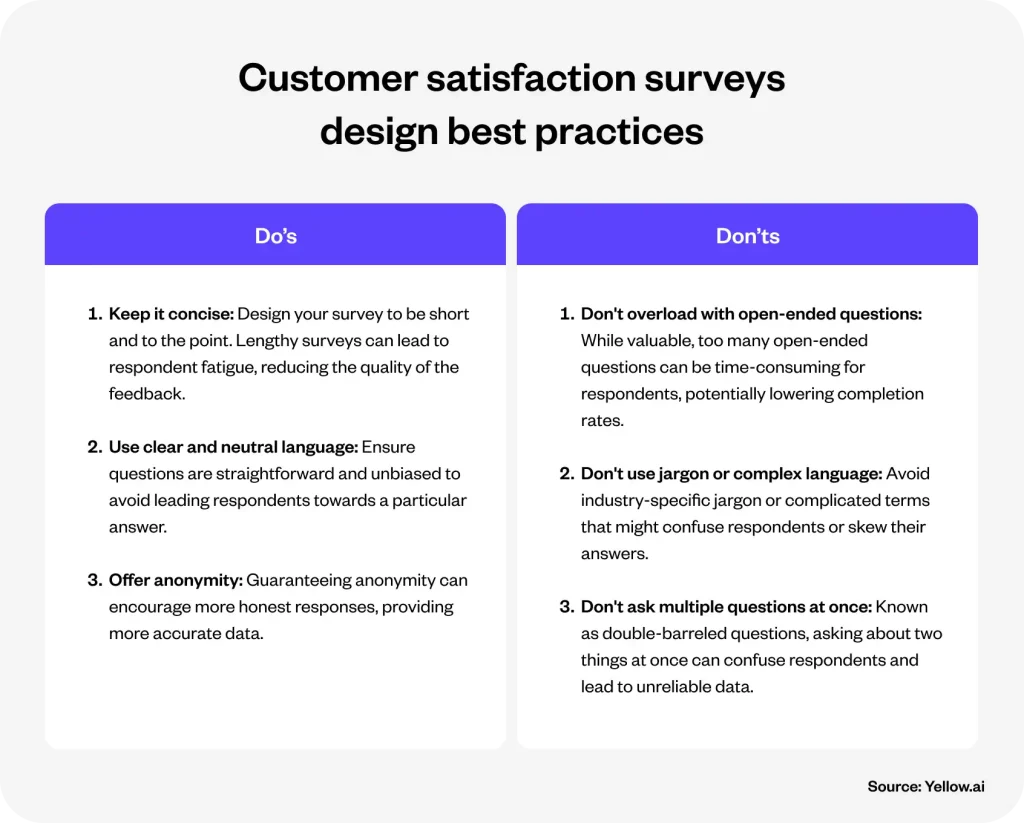Customer satisfaction surveys stand at the forefront of today’s business strategy, serving as a critical indicator for organizations keen on understanding and enhancing their customer experience. A revealing statistic from a Zendesk survey highlights the urgency: after just one or two negative experiences, around 80% of consumers are prepared to jump ship to a competitor. This stark reality underscores the importance of not only measuring customer satisfaction but doing it effectively and insightfully.
Customer satisfaction surveys offer a bridge from mere speculation to actionable insights. This blog invites you on a journey to explore how these surveys can elevate your business’s customer experience to unparalleled heights. From the art of crafting the right questions to the analytical prowess needed to sift through feedback for golden insights, we’re here to guide you through harnessing the power of Customer Satisfaction Surveys for a definitive competitive edge.
In our exploration, we will dive into the myriad benefits of customer satisfaction surveys, outline methods for accurately measuring customer satisfaction, differentiate types of customer experience surveys, recommend effective customer satisfaction survey questions, share best practices for survey design, and elucidate how to act on your customer satisfaction survey results. Join us as we navigate the path to transforming merely satisfied customers into true brand advocates, setting your business apart in the competitive marketplace.
What are customer satisfaction surveys?
Customer satisfaction surveys are vital tools that measure how satisfied customers are with a company’s products, services, or interactions. These surveys use a straightforward scale, ranging from highly dissatisfied to highly satisfied, to quantify the customer experience. The aim is to provide businesses with clear insights into where they stand in their customers’ eyes, helping them to recognize their strengths and identify areas needing improvement. For any business committed to enhancing its customer experience, understanding these metrics is key to driving strategic decisions and fostering customer loyalty.
By implementing customer satisfaction surveys, companies establish a direct line of feedback with their customers, underscoring the business’s dedication to valuing and acting upon customer input. This practice not only highlights potential improvement points but also strengthens customer relationships by making them feel heard and valued. Ultimately, this leads to a more loyal customer base and transforms satisfied customers into brand advocates. Through the targeted use of these surveys, businesses can refine their offerings and customer interactions to better meet and exceed customer expectations in a competitive landscape.
Benefits of customer satisfaction surveys
Understanding the impact of customer satisfaction surveys extends beyond mere metrics; it’s about harnessing insights that drive business growth. Below are the multifaceted benefits of these surveys, each revealing how they can transform customer feedback into actionable strategies for success. Join us as we delve into the advantages that make customer satisfaction surveys an indispensable tool for any business.

1. Helps to build better products
Customer satisfaction surveys are catalysts for innovation and product enhancement. By directly tapping into the customer’s perspective, these surveys illuminate what users truly value in your products and where there’s room for improvement.
Imagine discovering, through pointed feedback, that users of your project management tool are struggling to navigate between messages and assignments. This insight provides a clear direction for innovation, such as introducing a feature that distinctly separates messages from tasks, thereby enhancing user experience and efficiency.
The real power of customer satisfaction surveys lies in their ability to validate these improvements. After implementing changes, a well-crafted survey can gauge the effectiveness of these updates, ensuring that the product evolution aligns with customer needs and expectations.
2. Reveals strengths and weaknesses
Customer satisfaction surveys serve as a mirror reflecting a business’s operational excellence and areas ripe for improvement. This feedback mechanism is invaluable for uncovering both the strengths that set your brand apart and the weaknesses that may be holding it back.
Often, businesses operate with blind spots—areas that might seem insignificant internally but are critical pain points for customers. These surveys peel back the layers of the customer experience, revealing insights into the buyer’s journey that may have otherwise gone unnoticed.
By systematically analyzing feedback, businesses can pinpoint specific moments in the buyer’s journey that delight customers, as well as those that frustrate or disappoint. This detailed understanding enables companies to double down on what works, leveraging these strengths as competitive advantages, while also addressing and rectifying weaknesses.
3. Improves customer relationships
Customer satisfaction surveys play a pivotal role in strengthening the bond between businesses and their customers, fostering a sense of value and understanding. When customers are invited to share their opinions and experiences, it sends a powerful message that their input is integral to the company’s growth and improvement strategy.
This act of reaching out for feedback demonstrates a commitment to listening and adapting based on customer needs and preferences, making customers feel respected and heard. Customers who see their suggestions and feedback lead to tangible changes are more likely to develop a deeper trust in the brand.
This trust, nurtured over time through consistent and meaningful engagement, can transform customers into brand ambassadors, inclined to share their positive experiences with friends and family.
How to measure customer satisfaction?
To effectively measure customer satisfaction, begin by conducting a survey and collecting responses. Then, calculate the composite score with this formula:
Sum of all scores / (Total number of responses × Maximum score per response) × 100 = % of satisfied customers
CSAT score calculation example
Imagine conducting a CSAT survey with a group of 8 customers, using a 5-point scale for responses. Here are their scores:
| Respondent | Respondent score | Maximum score |
| Customer 1 | 4 | 5 |
| Customer 2 | 5 | 5 |
| Customer 3 | 4 | 5 |
| Customer 4 | 3 | 5 |
| Customer 5 | 2 | 5 |
| Customer 6 | 5 | 5 |
| Customer 7 | 3 | 5 |
| Customer 8 | 4 | 5 |
Step-by-step calculation
- Add up all of the respondent scores: 4 + 5 + 4 + 3 + 2 + 5 + 3 + 4 = 30
- Calculate the maximum possible score: 8 customers × 5 points = 40
- Divide the total score by the maximum score: 30 ÷ 40 = 0.75
- Convert to a percentage: 0.75 × 100 = 75%
In this example, the composite customer satisfaction score is 75%, indicating that, on average, customers are quite satisfied with their experience. This simplified process provides a clear, quantifiable measure of customer satisfaction that can guide improvements and strategies.
Types of customer experience survey
Customer experience surveys reveal a variety of tools, each designed to capture a unique facet of the customer journey. From pinpointing immediate feedback post-interaction to understanding long-term loyalty, these surveys offer invaluable insights. Let’s explore the key types of customer experience surveys that can empower businesses to refine their strategies and enhance customer satisfaction.

1. Customer Satisfaction Score (CSAT)
The Customer Satisfaction Score (CSAT) captures immediate satisfaction with a service or interaction, measured by questions like, “How satisfied were you?” Responses range from binary options to numerical scales, making CSAT vital for assessing and swiftly addressing customer concerns.
CSAT surveys gauge overall satisfaction with specific business aspects, revealing precise insights—scores often exceed 98%. A significant drop in scores indicates urgent issues, allowing companies to quickly remedy problems and maintain customer experience standards.
Related read: How to improve customer satisfaction in 2024?
2. Net Promoter Score (NPS)
The Net Promoter Score (NPS) allows the direct measure of customer loyalty and satisfaction by asking a single question: “How likely are you to recommend our company or product to a friend or colleague?” Customers respond on a scale from 0 to 10, allowing businesses to classify them as detractors (0–6), passives (7–8), or promoters (9–10). The NPS is calculated by subtracting the percentage of detractors from the percentage of promoters, offering a clear metric of overall customer sentiment and loyalty.
NPS surveys are a strategic tool for assessing the effectiveness of your business in fostering long-term customer relationships. A higher number of promoters indicates strong customer satisfaction and loyalty, serving as a powerful indicator of your company’s potential for growth through positive word-of-mouth. Employing NPS allows companies to pinpoint areas for improvement and strengthen their strategies for building a loyal customer base.
3. Customer Effort Score (CES)
The Customer Effort Score (CES) evaluates how easily customers can use a product or resolve issues with customer support. It’s key for measuring the user experience, especially the effectiveness of your support system. CES surveys, often conducted after support interactions, inquire, “How easy was it to solve your problem?” with responses on a 5-point scale from ‘very difficult’ to ‘very easy.’

By tracking CES, companies pinpoint friction areas, aiming to simplify customer interactions. High CES scores suggest ease in resolving issues or using products, crucial for positive experiences and loyalty. Reducing customer effort not only improves satisfaction but also boosts retention and repeat business.
Customer satisfaction survey questions
Crafting effective customer satisfaction survey questions is an art that balances precision with engagement, aiming to elicit insightful responses that can guide business improvements. This section delves into the various questions that can uncover deep insights into customer satisfaction, preferences, and experiences. From rating scales to open-ended inquiries, we’ll explore examples of each question type, offering a toolkit for designing surveys that resonate with customers and yield actionable feedback.
1. Demographic questions
Demographic questions gather essential data about the characteristics of your customer base, aiding in the creation of detailed buyer personas. These insights are invaluable for tailoring marketing, sales, and support strategies to meet the specific needs of different customer segments. By asking demographic questions, businesses can not only confirm their existing customer data but also uncover new, insightful patterns that could drive revenue and enhance customer support.
Example questions
- What is your age range?
- In which geographic region do you reside?
- What is your occupation?
- What is your level of education?
- What is your annual household income?
2. Product usage questions
Product usage questions delve into how customers interact with your product or service, providing a window into the actual customer experience. These inquiries help uncover what aspects customers appreciate and which ones fall short of their expectations. By exploring the nuances of how your offering is used, you can pinpoint areas for enhancement, ensuring your product evolves in ways that bolster customer satisfaction and loyalty.
Related read: 10 Reasons why customer experience is important?
Example questions
- How often do you use our product or service?
- What features do you use the most?
- What challenges have you encountered while using our product?
- Is there a feature you wish our product had?
- How does our product meet your needs?
3. Quantitative customer feedback questions
Quantitative customer feedback questions are designed to convert subjective customer experiences into objective, numerical data that can be easily measured and analyzed. This type of question is crucial for validating assumptions about customer satisfaction, identifying trends, and making informed decisions based on concrete data. By quantifying customer feedback, businesses can more clearly see where they stand and what actions to take to improve.
Related read: Customer feedback: Types + 8 ways to collect It
Example questions
- On a scale of 1-10, how satisfied are you with our product?
- How likely are you to recommend our service to others, on a scale of 0-10?
- Rate the quality of our customer support from 1 (Poor) to 5 (Excellent).
- How well does our product meet your needs on a scale of 1-10?
- On a scale of 1-5, how easy was it to navigate our website?
4. Follow-up questions
Follow-up questions are crucial for understanding customer experiences after interactions like purchases or contacting support. These inquiries delve into perceptions and feelings about their experience, ensuring thorough feedback. By seeking feedback immediately after these interactions, businesses can gather timely insights essential for improvements and strategic planning.
Example questions
- How satisfied were you with your recent purchase experience?
- Was our customer support helpful in resolving your issue?
- Following your recent interaction with us, how likely are you to return?
- How could we have improved your last experience with us?
- What was your overall impression of our service during your last visit/contact?
5. Open-ended and long-form questions
Open-ended and long-form questions in customer satisfaction surveys provide a platform for customers to share their experiences and opinions in depth. This type of question invites descriptive responses, offering rich insights into the customer’s thoughts and feelings beyond what can be captured by ratings alone. The qualitative data gathered from these responses are invaluable for identifying opportunities for product enhancement, generating ideas for content, and pinpointing specific areas needing improvement.
Example questions
- What do you like most about our product and why?
- Describe a recent experience you had with our customer service.
- What improvements would you suggest for our product/service?
- Can you provide feedback on how our product could better meet your needs?
- Share any additional comments or experiences you’ve had with our company.
6. Nominal scale questions
Nominal scale questions classify responses into distinct, non-overlapping categories, providing valuable qualitative insights. These types of questions are particularly effective for segmenting your customer base according to specific characteristics or preferences. While they facilitate easy data collection and analysis by neatly categorizing responses, it’s crucial to craft these questions to capture the full spectrum of customer demographics or preferences without constraining their ability to fully express their views.
Example questions
- What is your gender?
- What is your occupation/industry?
- What is your education level?
- Which language do you prefer for communication?
- What is your marital status?
7. Ordinal scale questions
Ordinal scale questions gauge customers’ feelings or opinions through ranked responses, indicating levels of intensity or preference. These questions are invaluable for assessing subjective experiences like satisfaction, likelihood of recommendation, or agreement, offering clear gradations in customer attitudes.
Example questions
- Rate your satisfaction with our service (1-5).
- How likely are you to recommend us (1-10)?
- Agree or disagree: “Customer service was responsive” (1-5).
- Ease of use of our website (1-5)?
- Rate your experience with our latest product (1-5).
8. Likert scale questions
Likert scale questions utilize a five- or seven-point scale to measure customer sentiment towards a specific statement, typically ranging from strong disagreement to strong agreement. This type of question is especially effective for delving into the nuances of customer opinions, providing a more detailed view than simple binary choices. Likert scales are widely regarded for their reliability in capturing the degrees of customer satisfaction, preferences, and feelings.
Example questions
- I am satisfied with the quality of the product.
- The customer service met my expectations.
- I find the website easy to navigate.
- The pricing of the products offers good value for money.
- I would recommend this service to others.
9. Semantic differential questions
Semantic differential questions present customers with a scale between two polar adjectives, asking them to rate an interaction, product, or brand by selecting a point that represents their feelings. Typically utilizing a seven-point scale, this method captures the intensity of customer sentiments in a nuanced way, offering insights into perceptions that might not be as evident through other question types. Semantic differential scales are particularly useful for measuring attitudes, values, and views on a continuum from positive to negative extremes.
Example questions
- Rate your recent customer service experience from “Unhelpful” to “Helpful.”
- How would you describe the ease of use of our product, from “Complicated” to “Simple”?
- Evaluate your overall satisfaction with our brand from “Dissatisfied” to “Satisfied.”
- Describe the quality of our latest product update, from “Poor Quality” to “High Quality.”
- Assess the value for money of your purchase, from “Overpriced” to “Great Value.”
10. B2B questions
B2B survey questions are specifically designed to engage business professionals, focusing on evaluating interest in services or products to boost purchasing rates. These inquiries not only aim to gather actionable information on enhancing offerings but also seek to identify solutions to common business problems. Tailoring these questions to align with variables such as company size, job title, and industry ensures relevance and precision in feedback, facilitating more strategic business decisions.
Example questions
- How does our solution align with your current business needs?
- What features are most important to your business in selecting a [product/service]?
- In terms of company size, what challenges do you face in your industry?
- How likely are you to recommend our product/service to a business associate or partner?
- What improvements would you like to see in our offering to better serve your business?
B2C questions
B2C survey questions are crafted to connect directly with the general public or end-users of your offerings, contrasting with the business-focused nature of B2B inquiries. These questions primarily revolve around the consumer’s personal experience with a product or service, seeking insights into satisfaction, preferences, and areas for improvement. By targeting the individual experiences of consumers, B2C questions help businesses tailor their offerings to meet and exceed the expectations of their customer base.
Example questions
- How satisfied were you with your recent purchase from us?
- What motivated you to choose our product/service over competitors?
- Can you describe how our product/service has impacted your daily life?
- What aspect of our product/service were you least satisfied with, and how can we improve?
- How likely are you to purchase from us again in the future?
Customer satisfaction surveys design best practices
Designing effective customer satisfaction surveys is both an art and a science, requiring a balance between engaging questions and methodical structure. This section outlines the essential do’s and don’ts to consider, ensuring your surveys capture valuable insights while respecting the respondent’s time and experience.

Do’s:
- Keep it concise: Design your survey to be short and to the point. Lengthy surveys can lead to respondent fatigue, reducing the quality of the feedback.
- Use clear and neutral language: Ensure questions are straightforward and unbiased to avoid leading respondents towards a particular answer.
- Offer anonymity: Guaranteeing anonymity can encourage more honest responses, providing more accurate data.
Don’ts:
- Don’t overload with open-ended questions: While valuable, too many open-ended questions can be time-consuming for respondents, potentially lowering completion rates.
- Don’t use jargon or complex language: Avoid industry-specific jargon or complicated terms that might confuse respondents or skew their answers.
- Don’t ask multiple questions at once: Known as double-barreled questions, asking about two things at once can confuse respondents and lead to unreliable data.
What to do with your customer satisfaction survey results?
After collecting customer satisfaction survey results, the next steps are crucial for leveraging this valuable feedback to improve your business. Here’s how to make the most out of the insights you’ve gathered.
1. Share the results with the right people
Sharing the survey results with stakeholders within your organization ensures that everyone is aligned on customer feedback and the actions required. This includes sharing insights with product development teams, customer service departments, and leadership. Transparent communication about customer satisfaction levels can foster a culture of continuous improvement, where every team member understands their role in delivering exceptional customer experiences.
2. Respond to feedback
Actively responding to the feedback received, whether positive or negative, is essential. For positive feedback, thank customers for their support and highlight how their input contributes to your service or product improvement. For negative feedback, reach out to understand more and communicate the steps you’re taking to address their concerns. This shows customers that you value their opinions and are committed to enhancing their experience.
3. Look for trends and patterns
Analyzing the data for recurring themes or patterns can uncover insights into broader issues or opportunities. Trends can indicate areas where your business excels and where there’s room for improvement. Identifying these patterns helps prioritize changes that could have the most significant impact on customer satisfaction. Use this analysis to inform strategic decisions and drive targeted initiatives aimed at enhancing the overall customer experience.
Enhancing customer satisfaction surveys with Yellow.ai
Yellow.ai redefines the approach to customer satisfaction surveys by integrating AI-powered solutions that automate and enrich the feedback process. By leveraging advanced AI, Yellow.ai elevates the efficiency and effectiveness of gathering and acting on customer feedback. So, let’s discover how leveraging Yellow.ai can transform the way you conduct customer satisfaction surveys, leading to unparalleled insights and improved customer experiences.
Automated survey distribution
Yellow.ai enables omnichannel communication for automated distribution of customer satisfaction surveys across multiple channels, ensuring a wider reach and higher response rates. This automation allows for timely feedback following customer interactions, capturing immediate insights.
| <Block>Unify your CX with omnichannel AI automation <Block> <button>Explore Now<button> |
Intelligent response analysis
Leveraging AI, Yellow.ai can analyze open-ended responses at scale, extracting key themes and sentiments. This capability provides deeper insights into customer feedback, beyond what is possible through manual analysis.
Personalized interaction
With AI-driven personalization, Yellow.ai tailors survey questions based on the customer’s previous interactions and feedback. This personal touch increases engagement and yields more accurate responses.
Real-time feedback loop
Yellow.ai facilitates a real-time feedback loop, allowing businesses to quickly act on customer insights. Immediate responses to feedback can enhance customer satisfaction and loyalty.
Integrated support solutions
By integrating with ticketing and support systems, Yellow.ai ensures that actionable feedback is swiftly routed to the right teams, streamlining the resolution of customer issues identified through surveys.
Predictive insights
Utilizing advanced analytics, Yellow.ai can predict customer trends and satisfaction levels, empowering businesses to proactively make changes that enhance the overall customer experience.
Conclusion
In the landscape of modern business, the value of customer satisfaction surveys cannot be overstated. These tools not only serve as a direct line to the customer’s thoughts and preferences but also as a critical resource for shaping the future of products, services, and overall customer experiences. Through careful crafting of survey questions, strategic analysis of feedback, and responsive action plans, businesses can turn customer insights into actionable strategies that drive satisfaction, loyalty, and advocacy.
Moreover, in this journey towards enhanced customer engagement and satisfaction, Yellow.ai emerges as a pivotal ally. With its AI-powered suite designed to automate and optimize the customer feedback process, Yellow.ai stands ready to transform how businesses gather, analyze, and act on customer satisfaction insights. In conclusion, leveraging customer satisfaction surveys offers businesses an unparalleled opportunity to deepen their understanding of customer needs, forge stronger relationships, and secure a competitive edge in the ever-evolving market.
Elevate your customer satisfaction survey game


















